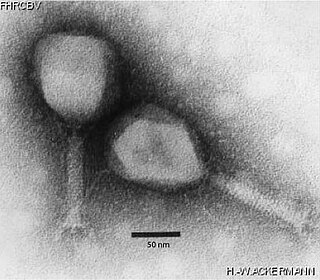
Podoviridae is a family of bacteriophage in the order Caudovirales often associated with T-7 like phages. There are 130 species in this family, assigned to 3 subfamilies and 52 genera. This family is characterized by having very short, noncontractile tails. Podoviradae are largely understudied and most new isolates are of the phicbkviruses genus, a group of giant viruses that appear to be Caulobacter specific.
Microviridae is a family of bacteriophages with a single-stranded DNA genome. The name of this family is derived from the ancient Greek word μικρός (mikrós), meaning "small". This refers to the size of their genomes, which are among the smallest of the DNA viruses. Enterobacteria, intracellular parasitic bacteria, and spiroplasma serve as natural hosts. There are 22 species in this family, divided among seven genera and two subfamilies.

Alphaherpesvirinae is a subfamily of viruses in the family Herpesviridae, primarily distinguished by reproducing more quickly than other subfamilies in the Herpesviridae. In animal virology the most important herpesviruses belong to the Alphaherpesvirinae. Pseudorabies virus is the causative agent of Aujeszky's disease in pigs and Bovine herpesvirus 1 is the causative agent of bovine infectious rhinotracheitis and pustular vulvovaginitis. Mammals serve as natural hosts. There are currently 45 species in this subfamily, divided among 5 genera with one species unassigned to a genus. Diseases associated with this subfamily include: HHV-1 and HHV-2: skin vesicles or mucosal ulcers, rarely encephalitis and meningitis, HHV-3: chickenpox (varicella) and shingles, GaHV-2: Marek's disease.

Iltovirus is a genus of viruses in the order Herpesvirales, in the family Herpesviridae, in the subfamily Alphaherpesvirinae. Birds, galliform birds, psittacine birds, chickens, turkeys, and quail serve as natural hosts. There are only two species in this genus. Diseases associated with this genus include: acute respiratory diseases: gaHV-1: infectious laryngotracheitis; psHV-1: Pacheco's disease.

Secoviridae is a family of viruses in the order Picornavirales. Plants serve as natural hosts. There are 8 genera and 86 species in this family, one of which is unassigned to a genus. The family was created in 2009 with the grouping of families Sequiviridae, now dissolved, and Comoviridae, now subfamily Comovirinae, along with the then unassigned genera Cheravirus, Sadwavirus, and Torradovirus.
Picovirinae is a subfamily of viruses in the order Caudovirales, in the family Salasmaviridae. Bacteria serve as natural hosts. There are two genera and seven species in this subfamily.
Uetakevirus is a genus of viruses in the order Caudovirales, in the family Podoviridae. Bacteria serve as natural hosts. There are three species in this genus. These phages are temperate and infect Salmonella and Escherichia coli.
Proboscivirus is a genus of viruses in the order Herpesvirales, in the family Herpesviridae, in the subfamily Betaherpesvirinae. Elephants serve as natural hosts. EEHV1 is apathogenic for African elephants but causes fatal haemorrhagic disease in Asian elephants. The name "Proboscivirus" comes from the Greek word προβοσκίς or "proboscis" meaning "the elephant trunk," for which the virus accordingly uses as its means of contraction and transmission to enter the elephant's body.
Punavirus is a genus of viruses in the order Caudovirales, in the family Myoviridae. Bacteria serve as natural hosts. There are four species in this genus.
Peduovirus is a genus of viruses in the order Caudovirales, in the family Myoviridae, in the subfamily Peduovirinae. Bacteria serve as natural hosts, with transmission achieved through passive diffusion. There are 15 species in this genus.
Tequatrovirus is a genus of viruses in the order Caudovirales, in the family Myoviridae, in the subfamily Tevenvirinae. Gram-negative bacteria serve as the natural host, with transmission achieved through passive diffusion. There are 75 species in this genus.
Felixounavirus is a genus of viruses in the order Caudovirales, in the family Myoviridae. Bacteria serve as natural hosts, with transmission achieved through passive diffusion. There are currently 16 species in this genus, including the type species Salmonella virus FelixO1.

Tevenvirinae is a subfamily of viruses in the order Caudovirales, in the family Myoviridae. Bacteria and archaea serve as natural hosts. There are 135 species in this subfamily, most included in 12 genera.
Myohalovirus is a genus of viruses in the order Caudovirales, in the family Myoviridae. Bacteria and archaea serve as natural hosts. There are three species in this genus.

Teseptimavirus is a genus of viruses in the order Caudovirales, in the family Autographiviridae, in the subfamily Studiervirinae. Bacteria serve as the natural host, with transmission achieved through passive diffusion. There are currently 17 species in this genus, including the type species Escherichia virus T7.
Salasvirus is a genus of viruses in the order Caudovirales, in the family Salasmaviridae, in the subfamily Picovirinae. Bacteria serve as natural hosts. There are four species in this genus.
Lambdavirus is a genus of viruses in the order Caudovirales, in the family Siphoviridae. Bacteria serve as natural hosts, with transmission achieved through passive diffusion. There are five species in this genus. The genus also includes several unclassified viruses—including the corynephages β and ω, which infect Corynebacterium diphtheriae and carry the deadly diphtheria toxin.
Tequintavirus is a genus of viruses in the order Caudovirales, in the family Demerecviridae. Bacteria serve as the natural host, with transmission achieved through passive diffusion. There are currently 22 species in this genus, including the type species Escherichia virus T5.
Macavirus is a genus of viruses in the order Herpesvirales, in the family Herpesviridae, in the subfamily Gammaherpesvirinae. Mammals serve as natural hosts. There are nine species in this genus. Diseases associated with this genus include: inapparent infection in their reservoir hosts, but fatal lymphoproliferative disease when they infect MCF-susceptible hosts, including cattle, deer, bison, water buffalo and pigs.
Percavirus is a genus of viruses in the order Herpesvirales, in the family Herpesviridae, in the subfamily Gammaherpesvirinae. Mammals serve as natural hosts. There are six species in this genus. Diseases associated with this genus include: conjunctivitis, immunosuppression in foals, pneumonia, respiratory disease.





